calsfoundation@cals.org
Night Riders
aka: Nightriders
aka: Whitecappers
aka: White Cappers
The term “night riding” is frequently synonymous with “whitecapping” or “bald knobbing,” all terms denoting extralegal acts of violence targeting select groups and carried out by vigilantes under cover of night or disguise. Beginning in the 1900s, cotton farmers throughout Arkansas, Mississippi, Tennessee, and Missouri were often the targets of night riders seeking to intimidate farmers into selling their crops at higher prices than offered by the big agricultural companies. However, many instances of night riding had racial overtones that hearkened back to the days of the post-Reconstruction Ku Klux Klan (KKK).
Cotton men of the state had formed the Arkansas Farmers Union in the early 1900s in order to stabilize the price of cotton, but when cotton prices fell to ten cents per pound, poorer farmers responded with a kind of viciousness unparalleled since the lawlessness of the KKK during the late nineteenth century. In Greene County, a group of masked, armed men rode horseback from town to town, burning wagons of cotton and intimidating farmers to force cotton growers to hold their cotton for a price of thirty-five to forty cents. On September 29, 1908, the violence against cotton growers escalated with an attack against a farmer near Mainwood, about fifteen miles from Paragould (Greene County). Newspapers also reported attacks by night riders in Marmaduke (Greene County), Bethel (Greene County), Walcott (Greene County), Lake City (Craighead County), and Jonesboro (Craighead County), as well as other small farming communities in or near Greene County.
Night rider violence escalated into 1909. The riders staged spectacular nighttime raids, destroyed cotton in the fields, killed livestock, burned barns and warehouses filled with cotton, dynamited farm machinery, and assaulted buyers. As a way of restraining the night riders, on September 27, 1908, during an emergency meeting of the Farmers District Union of Marmaduke at the Greene County Courthouse in Paragould, merchants were asked to temporarily refrain from buying cotton.
Other factors besides price control, such as class and race relations, pitted landowners against tenant farmers and squatters. An expansion of the plantation system in the Arkansas Delta between 1880 and 1920 was challenged by a violent campaign on the part of landless whites. Whitecappers struck in Cross and Poinsett counties in 1902, in Crittenden County in 1904, and periodically plagued Mississippi County from 1908 to 1921. Frequently, landless whites committed acts of violence against African Americans, who, due to the race-based wages of the era, were working on these plantations for much less than the average white person would earn. The aim of night riders was to drive off these black laborers and thus reduce the labor pool. Such acts of night riding and whitecapping occurred not only in agricultural areas but also in towns built upon industry. For example, in Black Rock (Lawrence County) in 1894, unemployed whites posted notices calling upon local mills and factories to discharge their black employees; these whitecappers remained sporadically active through the following years, attacking several African Americans in 1898.
Unlike people who perpetrated lynchings, night riders and whitecappers sometimes were arrested, had their identities made public, and were charged and convicted of their crimes. Federal judge Jacob Trieber convicted several whitecappers in 1904 in Helena (Phillips County). In 1909, the Arkansas General Assembly passed Act 112, which outlawed night riding. Although the law provided authorities with a new weapon, it by no means ended night-riding activities; indeed, in 1923, the law was used to charge the victims of night riding with that very crime in the aftermath of the Elaine Massacre and the Catcher Race Riot. Too, even local convictions on state or federal charges could prove easy to overturn upon appeal, as exemplified by the court cases of Hodges v. United States and Housley v. State.
Eventually, cotton prices rose due to an expanding European market, though some scholars believe that the violence committed by night riders did help keep cotton at profitable levels from 1905 to 1914. Sharecropping and tenancy began to undergo a profound transition beginning in the 1930s as a result of New Deal programs, World War II, mechanization, and the use of chemicals. All of this reduced the need for human labor in bringing in the cotton crop, and night riding directed against cotton planters faded away. Though violence against African Americans continued in Arkansas throughout the twentieth century, the large campaigns of night riding, like lynching, proved less and less sustainable over time.
For additional information:
Anthony, Michael. “Otherwise, You Will Have to Suffer the Consequences: The Racial Cleansing of Catcher, Arkansas.” PhD diss., University of Arkansas, 2023. Online at https://scholarworks.uark.edu/etd/4834/ (accessed October 23, 2023).
Easley, Tina. “Night Riders History.” Greene County, Arkansas, and Crossover Counties in Northeastern Arkansas, 1833 to 2010. http://www.usgennet.org/usa/ar/county/greene/nightridershistory%20te.htm (accessed February 22, 2022).
Eaton, H. L. “The Craighead County Night Riders, 1920–1921.” Craighead County Historical Quarterly 59 (July 2021): 3–10.
Hartman, Mary, and Ingenthron, Elmo. Bald Knobbers, Vigilantes on the Ozarks Frontier. Gretna, LA: Pelican Publishing Company, 1996.
Lancaster, Guy. “Nightriding and Racial Cleansing in the Arkansas River Valley.” Arkansas Historical Quarterly 72 (Autumn 2013): 242–264.
———. “‘Night Riding Must Not Be Tolerated in Arkansas’: One State’s Uneven War against Economic Vigilantism.” In Race, Labor, and Violence in the Delta: Essays to Mark the Centennial of the Elaine Massacre, edited by Michael Pierce and Calvin White. Fayetteville: University of Arkansas Press, 2022.
Lancaster, Guy, ed. “Nightriding in Arkansas.” Special issue, Arkansas Historical Quarterly 81 (Autumn 2022).
Mahoney, Martha R. “What’s Left of Solidarity? Reflections on Law, Race, and Labor History.” Buffalo Law Review 57.5 (2009):1515–1596. Online at http://www.buffalolaw.org/past_issues/57_5/Mahoney%20Web%2057_5.pdf (accessed November 10, 2021).
Matkin-Rawn, Story L. “‘We Fight for the Rights of Our Race’: Black Arkansans in the Era of Jim Crow.” Ph.D. diss., University of Wisconsin–Madison, 2009.
Pruden, William H. III. “Black Workers, White Nightriders, and the Supreme Court’s Changing View of the Thirteenth Amendment.” In Race, Labor, and Violence in the Delta: Essays to Mark the Centennial of the Elaine Massacre, edited by Michael Pierce and Calvin White. Fayetteville: University of Arkansas Press, 2022.
Whayne, Jeannie M. “Law, Villains and Wickedness in High Places: Race and Class in the Elaine Riots.” Arkansas Historical Quarterly 58 (Autumn 1999): 292–311.
Jeanie Horn
Marshall, Arkansas
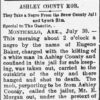 Baker, Eugene (Lynching of)
Baker, Eugene (Lynching of) Bonanza Race War of 1904
Bonanza Race War of 1904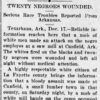 Canfield Race War of 1896
Canfield Race War of 1896 Civil Rights and Social Change
Civil Rights and Social Change Hampton Race War of 1892
Hampton Race War of 1892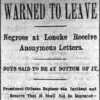 Lonoke County Race War of 1897–1898
Lonoke County Race War of 1897–1898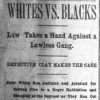 Nevada County Race War of 1897
Nevada County Race War of 1897 Paragould Race Riots
Paragould Race Riots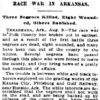 Polk County Race War of 1896
Polk County Race War of 1896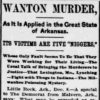 Southern Arkansas Race Riots of Late 1896
Southern Arkansas Race Riots of Late 1896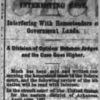 United States v. Waddell et al.
United States v. Waddell et al.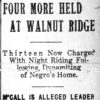 Walnut Ridge Race War of 1912
Walnut Ridge Race War of 1912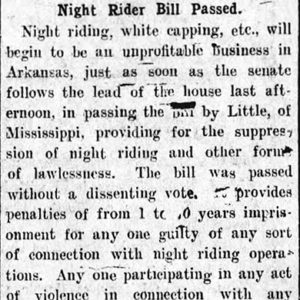 Night Rider Bill
Night Rider Bill 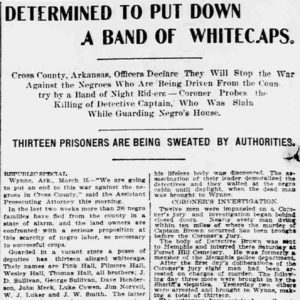 Night Riders Article
Night Riders Article 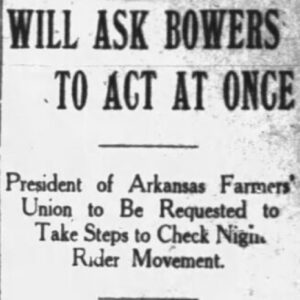 Night Riders Article
Night Riders Article 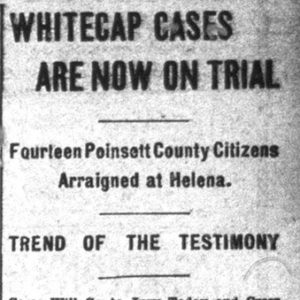 Whitecap Article
Whitecap Article 




Comments
No comments on this entry yet.